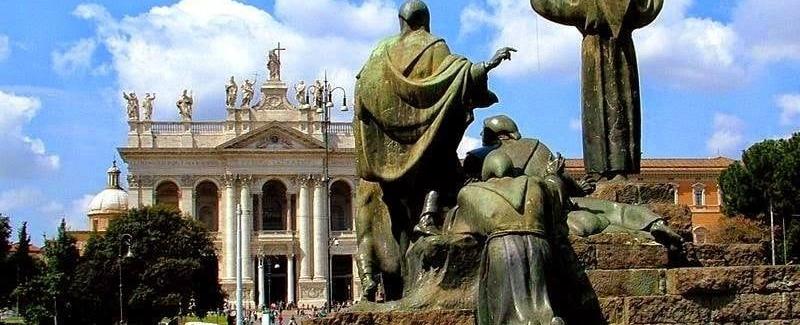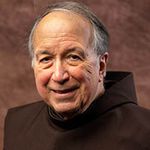Basilica of St. John Lateran: The Franciscan Connection

On November 9, Franciscans, along with the rest of the Catholic Church, celebrate the feast of the dedication of the Basilica of St. John Lateran.
The Pope’s cathedral
As the Pope’s cathedral as Bishop of Rome, the Lateran played an important role in early Franciscan history, as it was the seat of government of the Church at that time. There Francis and his first brothers traveled in 1209 to seek the approval of Pope Innocent III for their way of life.

Interior of Basilica of St. John Lateran
Approving the Franciscan Rule
A story was told in Franciscan circles about Francis’s visit to a hesitant Pope Innocent:
On hearing [Francis’s response to his questions], the pope was greatly amazed, especially since, before blessed Francis’s arrival, he had seen in a vision the church of St. John Lateran threatening to collapse, and a religious, small and of shabby appearance, supporting it on his own shoulders. . . A few days later, blessed Francis came to him, made known his proposal, and asked him to confirm the rule he has written in simple words, using the words of the holy Gospel, for whose perfection he fully longed. As he was reflecting on how enthusiastic blessed Francis was in God’s service, and comparing his vision with that shown to the man of God, he began to say to himself: “This is indeed that holy and religious man through whom the church of God will be sustained and supported.” So he embraced him and approved the rule he had written. (Legend of the Three Companions, 51)

The dream of Pope Innocent III (Basilica of San Francesco, Assisi, 1297–1300). Traditionally ascribed to Giotto.
Franciscans become basilica's official confessors
Several years later, in 1215, the Fourth Lateran Council was held in the church, whose legislation would profoundly affect the Franciscan movement. Some believe that Francis was present at the Council. Soon the Lesser Brothers were moving into the ministries of popular preaching and the hearing of confessions which were emphasized by the Council. Today the Friars Minor serve as the official confessors at the Lateran basilica.

The great mosaic in the apse of the Lateran Basilica. It is interesting that inserted between the large figures from the New Testament (from the left: Paul, Peter—the patrons of Rome—and the Blessed Virgin; on the right side: John the Evangelist and John the Baptist—the patrons of the Lateran Basilica, and Andrew), we see the smaller figures of St. Francis on the left and St. Anthony of Padua on the right. Francis and Anthony have a place in the mosaic because it was commissioned by the first Franciscan Pope, Nicholas IV (1288–1292), who is also depicted here, kneeling at the feet of Mary. The chief artist of this mosaic was Jacopo Torriti, assisted by a Franciscan friar mosaic artist, Jacopo of Camerino.
Celebrating Gospel life and wide mission
On this feast, Franciscans reflect and celebrate the providential union of their Gospel way of life with the wider mission of the Church!
-----
Main image: Monumental statue of St. Francis and his first companions approaching the basilica of St. John Lateran. This statue was erected in 1925-1927 to commemorate the 700th anniversary of the death of St. Francis. (photo by Greg Friedman, OFM)
Dominic Monti, OFM
Professor of Franciscan Research in the Franciscan Institute of St. Bonaventure University
Dominic V. Monti, OFM, is a Franciscan Friar of Holy Name Province (USA) and currently professor of Franciscan Research in the Franciscan Institute of St. Bonaventure University. He devoted the greater part of his ministry to teaching the History of Christianity, in particular the history of the Franciscan movement. He has contributed two volumes to the Works of St. Bonaventure series and is author of Francis & His Brothers, a popular history of the Friars Minor.

